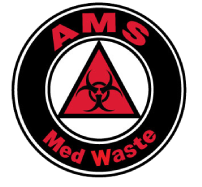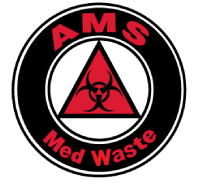Needlestick injuries pose a substantial occupational risk in healthcare settings, leading to potential transmission of bloodborne diseases such as HIV, hepatitis B, and hepatitis C. AMS MedWaste recognizes the importance of proper compliance and effective training for healthcare staff the need to dispose of needles and sharps safely and in approved containers.
Compliance & Safety
The Needlestick Safety and Prevention Act (NSPA) of 2000 and the Occupational Safety and Health Administration (OSHA) mandates are prime examples of compliance methods that healthcare facilities must adhere to. These regulations enforce the use of safer needle devices, maintenance of a sharps injury log, proper disposal of sharps, usage of personal protective equipment, and adequate training for healthcare workers.
Safety Measures for Needlestick Prevention
AMS MedWaste encourages healthcare facilities to work with their sharps providers to integrate safety practices into their daily routines and using appropriate sharps containers for safe disposal. Some of the industry-recommended measures include:
Needleless Systems: These systems employ alternative methods like blunt cannulas or spray nozzles to administer medication or draw blood, effectively eliminating sharps in specific procedures.
Safety-Engineered Devices: Devices designed with safety features, like safety syringes, retractable needles, and protective shields, reduce the risk of needlestick injuries.
One-Handed Recapping Devices: These devices enable healthcare workers to recap needles with one hand, minimizing injury risk.
Automated Medication Dispensing Systems: These systems reduce manual preparation and administration of medications, thereby decreasing needlestick injury risks.
Improved Sharps Disposal: Providing more disposal containers at convenient locations, implementing safe disposal policies, and ensuring proper sharps waste disposal can significantly reduce needlestick injuries.
Enhancing Safety
Training
Regular training on handling and disposing of sharp objects and guidance on dealing with needlestick injuries is crucial. Immediately after a needlestick injury, it should include washing the affected area, reporting it to a supervisor, seeking medical attention, following prescribed treatment plans, cooperating with the facility’s incident reporting system, and participating in follow-up testing and monitoring.
Protocols
Healthcare providers should establish clear protocols for handling sharp objects and their safe disposal. These protocols should include guidelines on using personal protective equipment (PPE), avoiding manual recapping of needles, disposing of sharps in puncture-resistant specific sharps containers, using safer needle devices, reporting all needlestick injuries, and seeking immediate medical attention after exposure.
Incident Reporting
Incident reporting is vital in preventing needlestick injuries. It helps identify trends and areas for improvement and informs the development of new policies and procedures to mitigate future risks. It also ensures healthcare workers receive prompt medical attention and preventive measures like post-exposure prophylaxis.
Join the AMS MedWaste Safety Initiative Today!
AMS MedWaste is committed to promoting a safer healthcare environment by helping facilities prevent needlestick injuries. With the proper training, compliance, safety measures, and protocols, we can significantly reduce the risk of these injuries and protect healthcare workers from bloodborne diseases.
We can equip your staff with the appropriate containers and service scheduled to dispose of sharp objects safely.
We also assist in establishing clear protocols for handling sharps and safe disposal, ensuring your facility’s operations align with regulations such as the Needlestick Safety and Prevention Act and OSHA mandates.
Preventing needlestick injuries is a shared responsibility. Let’s work together to create a safer healthcare environment. Contact AMS MedWaste today and join the safety initiative!






